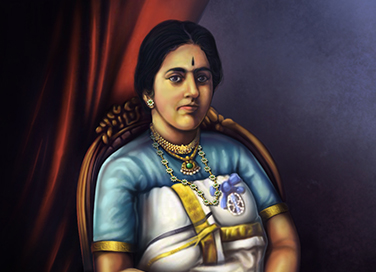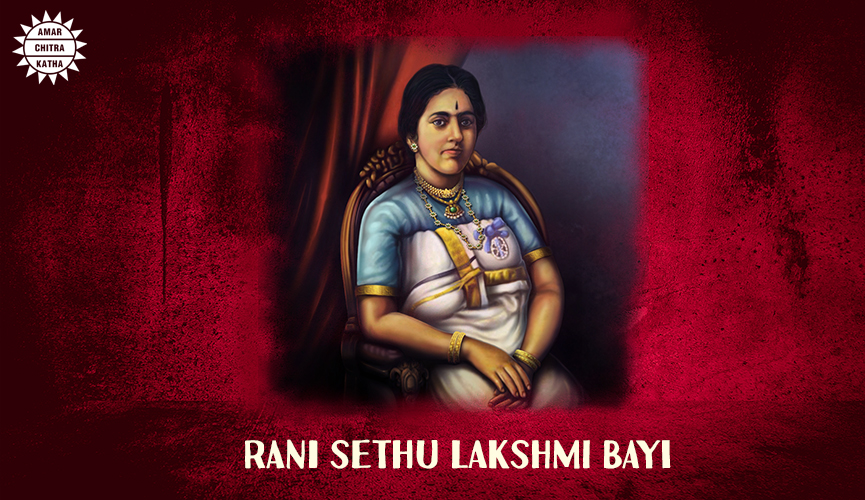Sethu Lakshmi Bayi
- May 31, 2023


Sethu Lakshmi Bayi
- May 31, 2023
By Sinchana Shetty
Seldom do stories start with “Once upon a time there was a queen…” as kings seem to have taken precedence over the queens in history. However, this story about Maharani Sethu Lakshmi Bayi starts with the triumphant tune of “Once, there lived a queen…”
To receive more such stories in your Inbox & WhatsApp, Please share your Email and Mobile number.
The Travancore dynasty ruled from 1729, over most of the south of Kerala and the southernmost part of modern-day Tamil Nadu. The Travancore family was matrilineal, where succession passed through the female lines. This meant that the throne did not go from father to son but rather, to a sister’s son. Since at the time the royal family came to consist solely of Maharajah Moolam Thirunal, Senior Rani Lakshmi Bayi and her two nephews; the Senior Maharani decided to adopt the daughter of her nieces. As such, Pooradam Thirunal Sethu Lakshmi, the granddaughter of artist Raja Ravi Varma was adopted into the Kingdom of Travancore.
Since King Moolam Thirunal died and his heir to the throne was only 12 years old at the time, a regency became necessary until the minor King Chithira Thirunal came of age. So, in September 1924, Sethu Lakshmi Bayi became the Maharani of the Kingdom of Travancore. Though a regent, she ruled as a monarch due to the matrilineal system which gave women equal power and right to reign.
During her rule, Sethu Lakshmi Bayi abolished the Devadasi system. This was a practice where women would dedicate themselves to the worship of a deity. This was harmful because the devadasis had no legal right to marry and were obligated to dedicate themselves to the deity for the rest of their lives. She also put a stop to the sacrifice of animals.
Sethu Lakshmi Bayi’s reign began with the Vaikom Satyagraha. At the time, people of lower castes were not allowed to enter the Vaikom Mahadeva Temple. Therefore, a satyagraha which was launched on 30 March, 1924, aimed at allowing temple entry for worship of god, irrespective of caste, creed or community. After her meeting with Mahatma Gandhi regarding the same, she opened the doors of the temple to all castes. Gandhi called this initiative by the queen a “bedrock of freedom” in a magazine.

In 1927, Sethu Lakshmi Bayi elevated the Trivandrum Women’s College, which offered non-professional, ‘ladylike’ courses, by offering courses in history, natural science, languages and mathematics. She did this by securing an affiliation with the University of Madras. Soon, over 9,500 women were enrolled in English-speaking schools in Travancore and 232 women were attending college.
The Maharani allowed female students to study law despite criticism imploring otherwise. Soon after, the state produced Miss Anna Chandy, who became the first woman judicial officer not only in Travancore but also of India.
The Maharani was devoted to the cause of women’s empowerment. While feminism would not have been a word relevant at the time, to call her a feminist icon would not be a mistake. She aimed to further women’s participation in the political sphere of the country.
In line with her aims, the Maharani promoted Dr Mary Poonen Lukose, the first woman to receive a medical degree from Travancore and a graduate of London University, from Surgeon-In-Charge of the Women and Children’s Hospital, to Head of the Medical Department of Travancore. Dr Mary was also the first woman to be elected to the Legislative Council after being nominated by the Maharani for the position. It was the first time a woman was named the head of a significant department in India, as well as the first time a “Lady Legislator” had been appointed from Travancore.
In 1928, the Maharani nominated another female legislator, Mrs Elizabeth Kuruvilla. Mrs Kuruvilla pushed for equal opportunity for men and women to hold public office. This allowed for many more women to follow their aspirations to pursue a career and seek independence.
Since this was a culture reset when many were used to women being those who toiled at home, the Maharani was subject to a lot of criticism. There was constant resistance to her progressive ideals.
By the end of 1931, the decision that Sree Chithira Thirunal would become king after his 19th birthday was made. As a result, after seven long years of rule, Sethu Lakshmi Bayi’s regency ended in November 1931.
A revolutionary in her own right, Sethu Lakshmi Bayi, was set in her ways, tirelessly aiming for her goals. Her success, often foreshadowed by her successor, must be brought to light. Therefore, to read about Maharani Sethu Lakshmi Bayi’s achievements becomes necessary to understand the powerful women in India’s history.
Shop for more such inspiring queens from Indian history in your nearest bookstore or the shop section of the Amar Chitra Katha website!
To receive more such stories in your Inbox & WhatsApp, Please share your Email and Mobile number.

Comic of The Month
The Naval Journey of India Book I
This book is the first of a three-book series that takes a deep and detailed look at India's Naval History and a deep insight into the lives of our men and women in white. But any series on the Indian Navy has to start at the very beginning - exploring India's celebrated maritime history. Join our little hero, Bharat, and his grandfather, Commodore Sagar, as they sail into the deep blue waters of time. Book I of The Naval Journey of India takes a sweeping look at India's maritime endeavours, how the seas impacted us over millennia and how the oceans made us who we are.